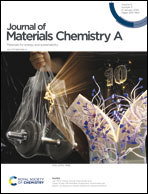Bi-metallic [Cu/Co(6mna)2]n metal organic chalcogenolate frameworks as high-performance electro-catalysts for dye-sensitized solar cells: a ligand-assisted bottom-up synthesis†
Abstract
Mercaptonicotinate-based metal organic chalcogenolate frameworks (MOFs), including [Cu2(6mna)(6mn)NH4]n-NO3, [Co2(6mna)2]n-NO3, [Co2(6mna)2]n-Cl, [Cu/Co(6mna)2]n-NO3, and [Cu/Co(6mna)2]n-Cl (6mna = 6-mercaptonicotinic acid; 6mn = 6-mercaptonicotinate), were newly introduced as the electro-catalytic counter electrodes in dye-sensitized solar cells (DSSCs). By using a ligand-assisted bottom-up synthesis, these five types of MOF films were covalently bonded to a conducting substrate to deliver their intrinsic electro-catalytic ability without any additives. The DSSCs coupled with all the carbon cloth/MOF electrodes showed a superior solar-to-electricity conversion efficiency (9.4%–10.0%) to the cell with a traditional carbon cloth/Pt electrode (9.3%), demonstrating their outstanding electrochemical activities. Heterogeneous bi-metallic MOFs, [Cu/Co(6mna)2]n-NO3 and [Cu/Co(6mna)2]n-Cl, outperformed their mono-metallic counterparts by increasing film roughness/porosity and decreasing the activation energy for I−/I3−. Their remarkable electrochemical performance was attributed to the successful synergistic effect, where [Cu2(6mna)(6mn)NH4]n-NO3 provided facile charge transfer via its 2D (–Cu–S–)n planes, while [Co2(6mna)2]n supplied large surface area and multiple electro-catalytic active sites through its helical (–Co–S–)n chains. With the use of different redox mediators (iodide, Co-phenanthroline, and Cu-neocuproine), the optimal carbon cloth/[Cu/Co(6mna)2]n-Cl electrode also showed better electro-catalytic ability and long-term stability than carbon cloth/Pt. Under room light illumination, higher cell efficiencies were obtained at 1.0 klux (19.5% for an office), 3.0 klux (23.3% for a shopping window), and 6.0 klux (26.4% for a lampshade), revealing the potential of mercaptonicotinate-based bi-metallic MOFs to be applied in various electrochemical devices.
![Graphical abstract: Bi-metallic [Cu/Co(6mna)2]n metal organic chalcogenolate frameworks as high-performance electro-catalysts for dye-sensitized solar cells: a ligand-assisted bottom-up synthesis](/en/Image/Get?imageInfo.ImageType=GA&imageInfo.ImageIdentifier.ManuscriptID=D3TA04970A&imageInfo.ImageIdentifier.Year=2024)


 Please wait while we load your content...
Please wait while we load your content...